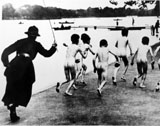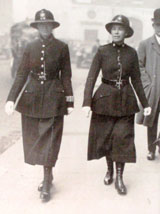The Work of the Women Police

The presence of uniformed female officers on the streets of London was striking. Indeed, former officers recalled having their photographs taken by tourists well into the 1950s. The uniform was modelled on that of male officers. It was very uncomfortable to wear, and deliberately created to invest its wearer with authority.
The use of the Women Police was justified in terms of their special role in policing. They followed a gendered pattern of work dealing primarily with women and children. From their inception, women police were involved in patrol work (especially parks and open spaces), escort duty (looking after juvenile and female prisoners) and hospital duty.

This famous photograph taken in Hyde Park in 1926 demonstrate that the duties undertaken by the women police now appear very petty.
The annual reports of the women police survive only from 1930, and testify to the type of work undertaken by these officers. This report from 1931 shows that women police arrested few people, they were more likely to issue cautions for 'bad' behaviour. Of the few people arrested, the vast majority were female. Yet it is important to note that while most women police undertook duties in uniform, a number of tasks, often related to offences by, and against, women and children, were undertaken in plain-clothes.
The Women Police Annual Report for 1934 gives an idea of the various tasks undertaken by women police during the inter-war period. Many of these tasks were geographically specific and an experimental reorganisation of June 1932 had concentrated the presence of women police in the inner divisions. The Establishment and Strength Report from 1935 shows the effect of this with the women police concentrated in the central divisions of 'A', 'C' and 'E' which covered the West End and Hyde Park.
 WPC 18 Ellis and Inspector Clayden patrolling outside Bow Street Police Station, 1924.
WPC 18 Ellis and Inspector Clayden patrolling outside Bow Street Police Station, 1924.